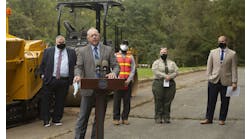Just before Labor Day weekend 2013, a fleet of 16 cold mills hustled night and day to prepare the east- and west-side approaches to the new Bay Bridge East Span for asphalt paving.
ABSL Corp., Hayward, Calif., labored under an incredibly tight schedule to mill huge swaths of the approaches to the new Bay Bridge East Span to prepare for the tie-in of existing highways with the new structure.
By the time paving began Labor Day weekend, ABSL had worked three days and nights nonstop, Wednesday evening through Saturday morning, removing approximately 1.1 million sq ft at depths of 2 to 3 in.
The widest and the longest
On Tuesday morning, Sept. 3, 2013, the new East Span of the San Francisco-Oakland Bay Bridge opened to traffic. Replacing an existing, two-deck, steel-truss structure that was deemed incapable of being fully upgraded to modern seismic standards, the new East Span is the widest bridge in the world, with a total deck width of 258 ft, including 10 lanes of roadway, a 15.5-ft-wide bike path and a gap where the central tower supports the two bridge deck sections.
Since 1936, the original East Span had facilitated the movement of people and goods throughout the Bay Area. The 7.1-magnitude Loma Prieta earthquake in 1989 significantly damaged the region’s transportation structures and exposed the vulnerability of the existing East Span. Since that day, the Toll Bridge Program Oversight Committee worked diligently to replace the original bridge and move everyone onto a safer structure. Following the safe rerouting of traffic to the new East Span, the original East Span will be demolished; that process will take approximately three years.
The new $6.4 billion bridge also has been honored with the title for longest self-anchored suspension span bridge in the world, with a length of 2,047 ft. When the bridge reopened to traffic, motorists encountered a new driving experience, as traffic was moved from the upper and lower decks of the original bridge to the parallel, side-by-side decks of the new East Span. The new side-by-side configuration opens up panoramic views of the San Francisco Bay and surrounding hills.
Ultimately, for the first time, pedestrians and cyclists will have the chance to travel across the San Francisco-Oakland Bay Bridge’s East Span, on a 15.5-ft-wide bike and pedestrian path that will extend the 2.2 miles to Yerba Buena Island.
But before the pathway can fully connect to Yerba Buena Island, crews will need to demolish a portion of the existing truss bridge that sits in the way of the new bike and pedestrian path. Contractors must dismantle portions of the original bridge, including the S-curve detour that was put into place in 2009, in order to install the rest of the path and connect it to Yerba Buena Island, as well as replace the temporary path at Oakland touchdown. The bike path is expected to be complete by summer 2015.
Another day of labor
In advance of its opening, over Labor Day weekend Wednesday, Aug. 28, through Sunday, Sept. 1, the Bay Bridge was completely closed to traffic. Work was done at the Oakland touchdown and toll plazas and the Yerba Buena Island transition to the west span of the Bay Bridge. Crews performed milling, paving, striping and erecting barrier rail.
Previously, the Bay Bridge was closed during Labor Day weekends in 2006, 2007 and 2009 while essential construction work was successfully completed on schedule. Taking advantage of historically light traffic on the bridge during the holiday weekend helps minimize disruptions to motorists, residents and businesses. Experience gained from previous closures helped Caltrans perform this construction safely again in late 2013, and the 2013 closure marked the final step before the new bridge was opened to traffic.
Quick to get ahead
They have built a new bridge and are closing the old bridge, and it was a great project for ABSL Construction, according to Luis Allende, president. ABSL Construction worked on the project throughout its duration, grinding before and after on the approaches, detours and lane reconfigurations. But Allende said the deck was the most important phase. On one day he had nine machines working on the east side and another three on the west side—a total of 12 machines at one time on one project.
An additional two machines on-site meant 14 total Wirtgen mills running at times, plus two backup Wirtgen mills.
With such a tight schedule, Wirtgen cold mills were giving Allende the machinery he needed to get the job done on time and on schedule. When visited on the Thursday before Labor Day, ABSL had three W 210s, two W 2100s and four W 2000s at work on the east side of the span and two W 2000s and three W 120 Fs working on the west side.
Allende’s fleet of milling machines completed their task hours ahead of schedule, without one breakdown. The operators did a great job on 12-hour shifts, he said, and they made a great team. R&B

